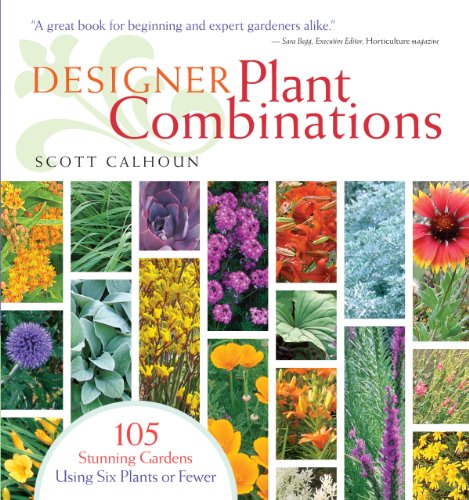Author Scott Calhoun has visited the gardens of top designers from coast to coast and selected more than 100 stunning plant combinations, each using no more than six plants, to include in this photographic guide. Riots of complementary colors, masses of grasses, foliage spectacles in extraordinary shades of green and purple, and height variations as arresting as city skylines are all featured in these exciting gardens, each one an intimate glimpse of a larger garden. A favorite pairing can be the beginning of a larger garden design, or a five-plant grouping might be all you need to fill a small urban garden. The possibilities are as varied as your imagination!
Designer Plant Combinations: 105 Stunning Gardens Using Six Plants or Fewer
• 11 years ago






Inspiring handbook for perennial addicts First of all the pictures–by the best garden photographers around. I doubt you will ever find such high quality reproduction or gorgeous pictures in such a convenient and incredibly inexpensive format. Second: diversity–what an extraordinary range of gardens, from cactus and desert stark to lush woodlands and of course classic English style herbaceous extravaganzas. By carving a manageable vignette out of what are often extremely complicated gardens, Scott makes it possible for the reader to duplicate the scene. More importantly, he shows how combos work: groundcovers melding together, focal point plants, see through designs–some nuts and bolts beautifully demonstrated. As well as being a very handy handbook, this is a valuable benchmark of garden design as practiced in America today: he’s picked gardens from California to the east coast and everywhere in between to sample the range of outstanding garden design comprising the American perennial garden. The world is awash with mercurial computer images that constantly disappear and flicker away: books like this are monuments that capture the moment. They will never be replaced by websites or digitization.Scott has produced four stunning and very different books in as many years. He is a force to be reckoned with: I don’t know anyone who wouldn’t be beguiled by the pictures and enlightened by the text. You will be delighted to own this one!
Useful Inspiration in a great package As anyone interested in gardening knows, there are thousands of books to choose from to help with garden design ideas. What sets this new book by Scott Calhoun apart is the absolutely perfect packaging for people like me who can’t devote their whole lives to their gardens, yet want them to look as if we did. I love the organization of the book (perennials, grasses, annuals, accent plants, groundcovers and woodies) but most of all I love the way the vignettes are presented. Each combination has a full shot of the plants together, then there are separate “pull-outs” of the individual plants which include the botanic name, cultural conditions, maintenance tips and propagation methods. Various “Designer tips” are also scattered throughout the book highlighting tricks and tips that will help the reader become a real pro. This book will appeal to gardeners of all levels, from the energetic novice to the professional looking for that inspirational “fix.” It’s a huge resource in a small package to keep alongside your garden gloves- make sure to pick it up every time you get ready to go out and “edit” your own garden.
The American Revolution in Garden Design There is a new language of garden design, and it is decidedly American. Appropriately named the New American Garden, it takes its inspiration from the recently introduced meadow gardens, the warm climate and flora of Southwestern USA, as well as a casual garden style that seeks to embrace the informality of nature. The New American Garden style is an alternative to traditional design. It is more relaxed, requires no deadheading or pesticides, and uses tough perennials such as Perovskia and Echinacea as well as ornamental grasses.The author makes it very clear that some old rules about gardens design no longer apply. We now allow ourselves greater freedom to combine plants in original and creative ways. Contemporary designers and horticulturalists have deconstructed the rigidity associated with traditional color groupings and borders. Greater value is given to texture and shape more than flowers and colors. Native plants are included in the designs and perennials are mixed with trees, shrubs, annuals, accent plants and grasses.It is apparent that when the author decided to introduce this topic to his readers, it was not his intention to design gardens, photograph them, and add some explanatory text. Instead, he consulted the best and the brightest in American horticulture and design, including the talented Dutch designer Piet Oudolf whose work represents a successful pushing of the boundaries of contemporary gardening.The book focuses on innovative ensembles, created by these prominent designers, using a maximum of 6 plants. The author and his colleagues believe that by limiting plants to no more than this number, one can create bolder, more cohesive, designs. The resulting plant combinations are not intended to be self-contained gardens, only portions of them. By breaking up a landscape into segments, readers will find it easier to start using plants in innovative ways.Another interesting development of the New American Garden has been the relaxed attitude towards perennial maintenance, recognizing seed heads for their beauty, form, and foraging value. Furthermore, the monotony of the flowerbeds may be broken up by planting in graduated heights by placing some tall plants at the front of the border. Contemporary designers encourage gardeners to include globe shaped plants such as Verbena bonariensis or Allium Christophii, tomentose plants whose little hairs seem to illuminate them, and neon-colored perennials such as Papaver Turkenlouis. When bold colored perennials are part of the plan, the gardener is encouraged to paint background walls in bright colors to balance out the bold. This is the only aspect of the new philosophy that did not sit well with this reviewer.The liberal use of ornamental grasses results in softening the usual stiff or formal plantings by adding movement and dynamism. This contributes a sense of wildness and feelings of spontaneity. Annuals are recommended to add color and excitement; they enliven, brighten, and fill in empty spaces. Bold sculptural plants such as Yucca and Agave are recommended for drama.The author and his colleagues also believe that diverse groundcovers are more interesting than lawns and that attractive patterns may be created when different groundcovers are mixed together. For an effective multicolor groundcover treatment in warmer gardening zones, the author suggests using red-yellow Gaillardia pulchella combined with blue Scenecio vitalis. Newer cultivars of colored Heuchera are effective groundcovers as well as they combine effectively with light green Persicaria Virginia Lance Corporal.The new phiolosophy also encourages the planting of woodland gardens that include trees and shrubs as they provide the largest benefits with the lowest maintenance. Today, it is possible to find dwarf trees and shrubs that have been bred for the shrinking American garden. These smaller plants combine quite successfully with interesting perennials as the structure of their foliage provides a backdrop for other plants.Readers who expect illustrated garden books to be breathtaking and awesome will not be disappointed. Mr. Calhoun has searched wide and far to include only the most eye-catching combinations in this book. The graphic design of this publication is also commendable as the layout of image, text, and detailed background information is incomparable. The reader will be impressed. For those that still believe that landscapes need to be designed in the antique manner of the English, this publication will be a revelation when they see how the Revolution of 1776 has finally trickled down to the gardens of North America.Allan Becker reviews books on gardening for (…) and for his blog , (…)
Comments are disabled for this post.